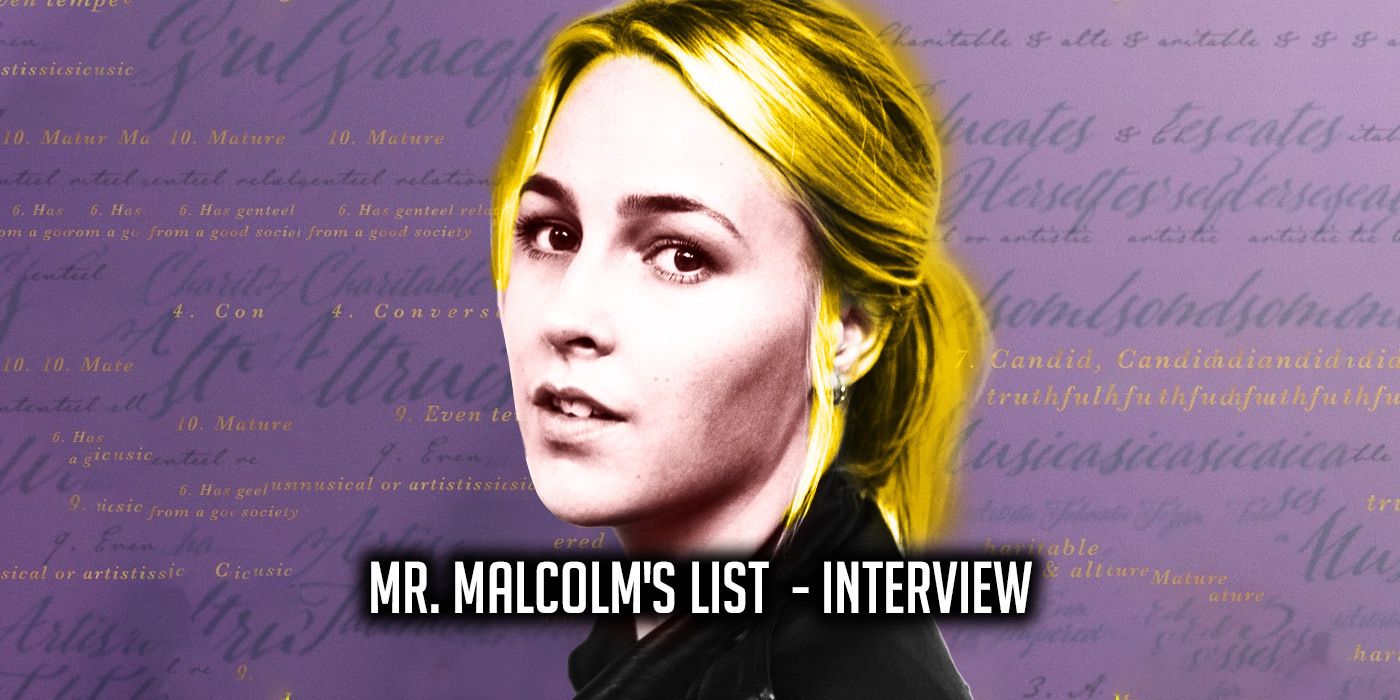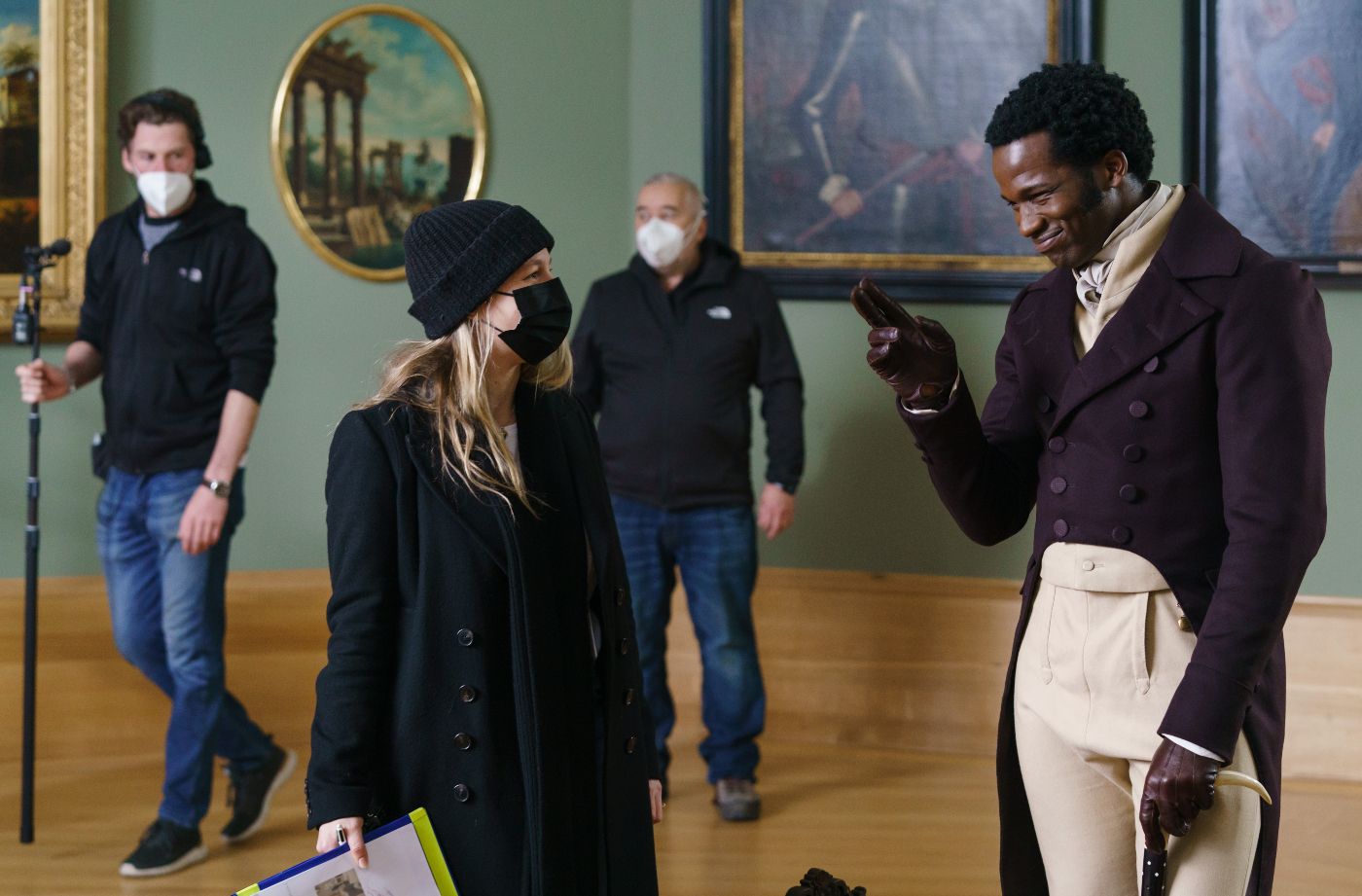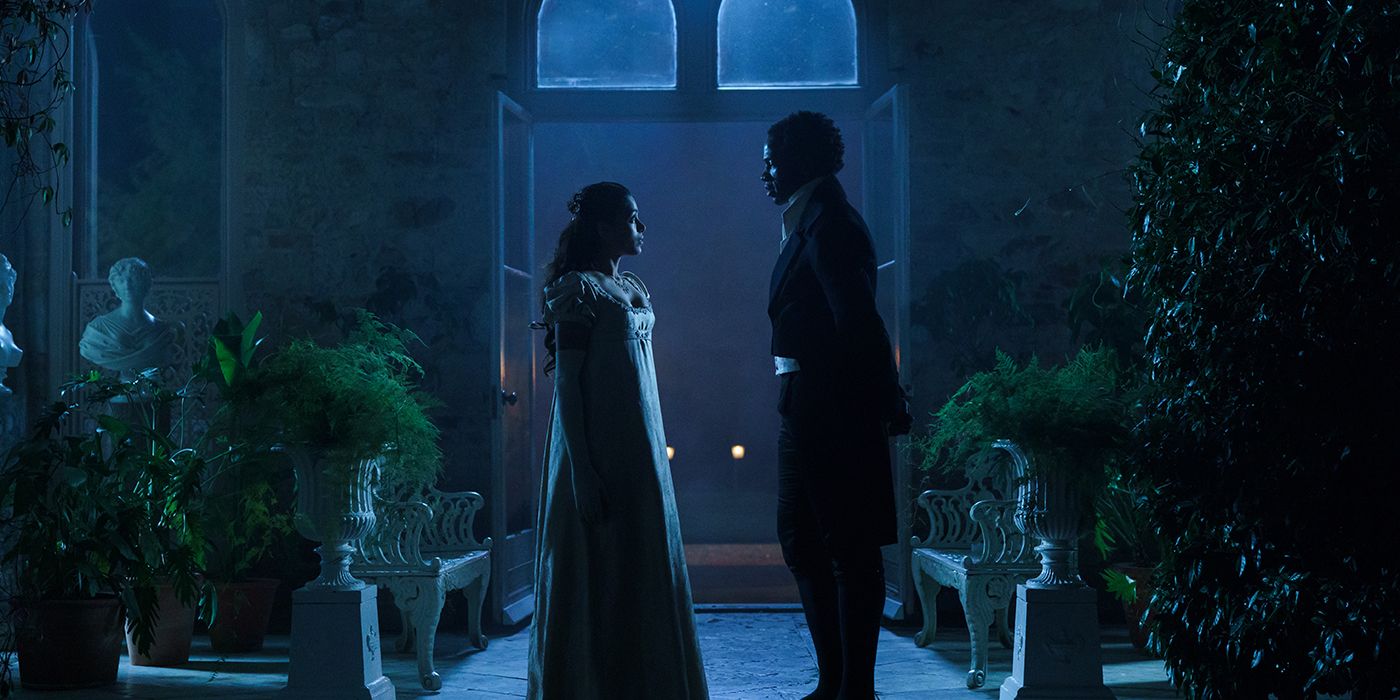From director Emma Holly Jones and writer Suzanne Allain (based on her book of the same name), Mr. Malcolm's List is a rom-com with a mountain of familiar genre trappings — only it happens to be set in 1800s England, where the titular Mr. Jeremiah Malcolm (Ṣọpẹ Dìrísù) is a much sought-after single gentleman who finds himself in want of a wife. The only thorny aspect is that he's made a list of standards that any potential bride is required to meet, and any he finds wanting in some manner is quickly and summarily discarded. When Julia Thistlewaite (Zawe Ashton) becomes the latest woman rejected by Mr. Malcolm — and made a laughingstock in society as a result — she reaches out to her long-time friend Selina Dalton (Freida Pinto) to assist her in hatching a plot of revenge. The plan? Selina will present herself as the ideal potential wife, emblematic of every qualification of Mr. Malcolm's list, only to turn around and reject him publicly so that he can experience the same mortification. However, as Julia and her cousin Lord Cassidy (Oliver Jackson-Cohen) prepare Selina to become Mr. Malcolm's perfect match, Selina finds herself falling for the man she's supposed to ruin. The film also stars Theo James, Ashley Park, Divian Ladwa, Naoko Mori, Sophie Vavasseur, and Sianad Gregory.
Ahead of the film's July 1 premiere, Collider had the opportunity to speak with Jones about directing the Regency-era romance feature — she was also at the helm for the 2019 short film, which starred Pinto, Dìrísù, and several others — and how the story of Mr. Malcolm's List first came to her attention. Over the course of the interview, which you can read below, Jones discusses why the material called her back to her own teen years, the biggest difference between directing the short film and the full-length feature, how Regency fans educated her on the importance of the "hand thing" in the genre, which scene in the movie was the toughest one to shoot, and more.
Collider: This project has had a long road from page to screen, but I would love to hear about when you first came on. How did you first come across the script? What attracted you to the story?
EMMA HOLLY JONES: I actually heard it on the Black List Table Reads podcast. It was a really original way to kind of discover a piece of material because I was driving my car, listening to the podcast, and I heard actors perform the script, so my imagination really did go quite wild because I think there's not much stage description or action description. You're really getting to listen to an interpretation of it by that group of people. I found that really quite a joyful way to... I wish all people could read me their scripts. I actually am very sad that the podcast is no longer going, because it was one of my favorite things to do when sitting in traffic in LA, and it just happened to be the place that I found my first film.
The thing that I was so drawn to in terms of what Suzanne [Allain] had written and done was it felt like a modern rom-com in its tone, in its conception. I've been saying this a lot the last two days. I think a lot of people assume I set out to make a Jane Austen-esque style thing. I really didn't. I was looking for that Richard Curtis-esque, Nora Ephron-esque rom-com. It just happened to be set in 1818, which I then realized is a really wonderful space for a rom-com because there's so much romantic stakes. There's no electricity. We've got carrier pigeons probably, and horses and carriages, and that's about it. So the idea of that "Will they? Won't they?" which is so important to a rom-com when we all fundamentally know the ending, that's what that sort of world gave me. I was just very, very, very excited to find something that, to me, harped back to those huge '90s inspirations from my teen years.
I know that you all made the short film first to garner interest in a longer feature. As the director, what lessons did you take away from making that short that informed your approach to the feature?
JONES: I have to say, if you want me to be completely honest, confidence. As a young female director, I think that short film provided me a space, a safe space actually, to test and experiment. I was making a huge jump from... I did a lot of documentary, commercial stuff. Single cameras roaming around, not much continuity, not many eyelines, so the technical elements of it were really fun to develop my knowledge, challenge myself. But I came out of it going, "I really want to do this." It was the best source of motivation.
I remember we shot the short in two and a half days, and the last day was the half-day. I remember getting to that lunch, and saying to Laura Lewis and the rest of the producers, "I don't want to stop." When you are getting your first film made, it's hard. It just is, end of. That short provided me so much confidence in what we were doing and what we were making as a company, but also the motivation to get up every day and keep fighting to get it made. On just a completely spiritual and emotional level, it was an absolutely wonderful thing to have the opportunity to do.
Truthfully, then, from a visual standpoint, as a filmmaker, I really, really enjoyed the visuals we had started to develop on the short film. With the feature, you get the opportunity to really put some scale into it, to really put some pace into it. You get to have a couple more tools lying around at your disposal, whether it's drones or steady-cams. I had one crane shot, and I chose it well, because it was still an indie budget, but that upping and scale was an extraordinarily fun thing to do. There's a lot of the crew and a lot of the cast who came over with us on that journey. Kate Hickey, my editor, is 100% the brainchild of John and Molly. It was massively her interpretation of the footage we were getting, alongside Divian and Sianad who were improving the entire time on set of the short film. John and Molly didn't exist in the original book or in the original script, and that was the sort of energy that was created on that short film, this family of people who really everyone was contributing ideas. The cast and the crew deserve all the credit in the world, and it's a wonderful place. It was like a test run, you know? So I was very lucky to have that opportunity.
Was there any scene sequence that you look back on that you're especially proud of making happen in spite of the circumstances? Something that you look at now and go, "I cannot believe we pulled this off"?
JONES: The masquerade ball, without a doubt. Lockdown was very, very tough on locations department, because people were getting cold feet. People were dropping out. We had five ballroom locations drop out so that in itself was actually hugely challenging for the entire company because production designers were having to go back to the drawing board, like, "Do we have to reorder new furniture? What works? How many bodies do we need? How many costumes do we need?"
We were, I think, already one week into shooting when this was going on, and Ray Ball, the production designer, called me, and he basically said, "I think we can turn the Hadley Hall drawing-room into the ballroom and do it purposefully." Then I quickly wrote that little bit with John and Molly dancing in the room afterward with all the footmen deconstructing the ballroom. That was almost like a huge saving grace, that he had this idea, because we had all the pieces in the trucks ready to go, and also we knew that the location wasn't going to get cold feet, and they weren't going to drop out on us. It's this wonderful house in Ireland called Killruddery House, and the owners of the space were incredible and so generous, even in the terms of the art they let us shoot, the actual furniture they let us use, because every step of the way we were having to save money and cut corners. Just from a pure production standpoint, that for me was a huge, huge thing that I'm like, "I can't believe we actually got there."
We made that scene with 46 background artists, which isn't many for a room that size, and that all comes down to incredibly crafty AD work from my second AD, my first AD, and my script supervisor, who were building maps with me in breaks, so every time the camera moved, we were moving this body of people with it. It made it feel full, and it made it feel like a party, and it made it feel busy, and really it's a lot of camera tricks and clever AD work.
One of the best things about any Regency romance on-screen for me is the placement of hands, hands that touch and linger, hands that almost don't quite touch. There are so many of those good moments in this movie. It's a little sexy, but it's still proper and restrained. How did you want to intentionally frame those moments in terms of playing up the growing romantic tension and emotional tension?
JONES: Yeah. So the hand thing is like a thing for the Regency romance. I kind of let the fans educate me on that. You know what I mean? Like the scene of the Mr. Darcy hand shake. I so very much wanted... There's actually three little moments in the film, and one's very, very subtle. Obviously, the one with the croquet, which was my one breathe in, breathe out moment. That moment, for me, was about what I realized: this is the first time Selina's probably ever been touched by a man. When you have a crush on someone, that butterfly feeling you get — that was very much, I felt, the perfect space for that, because it was also coming through as a very formal show of character for Malcolm, in using this situation to showcase how she was starting to feel towards him.
Our choreographer, Belinda, was incredible, and we spoke so much about the waltz, and we tried so many different variations of it — but the hands at the beginning, when he places her hand on his shoulder, that was all choreographed, and all the hands that intertwined. It was all the nod to some of those great fan moments. In talking about that waltz, Alex [Brambilla] was our camera operator. He shot every shot on the entire movie. He is an absolutely incredible steady camera operator. It changed the entire dynamic of that scene. It also harps back to what I was just saying. There is not one shot of that ball that is wide. There is not one shot of that ball that is large with all the dancing couples, because I couldn't do it. I didn't have the bodies. I didn't have the space. I didn't have the budget. It was COVID. Alex literally was like, "We are going to dance with them." If you know anything about steady cam, it is a quite hard thing to do for hours on end. It is heavy. You have to be quite strong. To be clear, Alex is six-foot-four. He's a big man. I have never seen someone of that presence and size dance a waltz for the camera.
It was truly one of the most magical moments for me on set when I watched those shots come together, because we knew what we had to cover. We knew the story beats of that scene. We had all these aerial maps of where people were going to be and what they were doing. We knew that we had this list of... I think it was like 27 major beats we had to capture and then make sure the continuity was correct. But those shots, we spent an entire afternoon just doing different iterations of steady cam shots. There was no direction. There was no plan. It didn't matter if you got a grip in the shot in the background. We knew we were going to be editing around that. It was about being with them and letting that camera feel like it was part of their breathing. You know? And then it was one of the hardest things we cut because of the continuity, right? Because you've got to remember, everyone's moving around them in a circle. So it really limits how you can piece it together. I think we spent a solid week just on that one two-minute sequence.
I also have to shout out Amelia Warner, who wrote that piece of music in that scene before we had shot a day. She was sitting and reading the script. I knew as a director already that I wanted to do: life melts away, and suddenly we turn; we lose the waltz, and we hear their score. I knew I wanted to do that moment from day one, so Amelia had to write something that we could choreograph to in advance and rehearse to. Then we worked backward and found Ian Neil, my music supervisor, then worked backward to find the Schubert piece that blended with the tempo of that choreography.
We spent three days shooting that scene. Every single person who worked on that film contributed to it in some way that made it a success and made it better, and everyone was going for the romance at that moment. Between Alex, Kate, Amelia, Ṣọpẹ, Freida, Belinda, it just came together and everyone was working towards the same thing. It was the first moment I cried on set, when I sat behind that monitor, when I watched that shot. I think we have a video of it on my phone somewhere if we need any material. I remember looking at the producers, and they were tearing too, but it was a really special moment. It's so funny you mentioned the hand thing, because the choreographer would tell you it's a hundred percent the inspiration for it, so it's lovely when people pick up on that stuff.
Mr. Malcolm's List is now playing in theaters.




